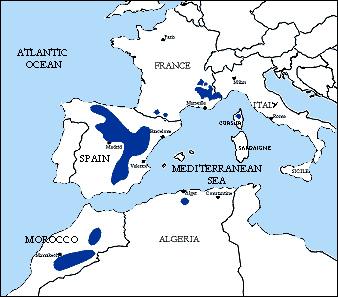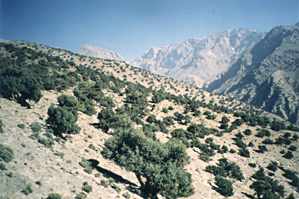THE THURIFEROUS JUNIPER (Juniperus
thurifera) IN MOROCCO
GENERAL PRESENTATION
|
The thuriferous juniper
(Juniperus thurifera L. ) is located on the western part of the Mediterranean
basin (see the map below). We can find this species in France, in Spain, in
Algeria and in Morocco, on a scattered area ranging from 100 to 150 000 ha.
- In France, the
thuriferous juniper is located in Alps, Pyrenees and Corsica. In
villages, this tree has several names like "le savinier"
(Fournier, 1948), "le chaï" (Lathuillière, 1994), "loù
savin" (Charras, 1993), "mourenc" (Lathuillière,
1994), or "sabine en arbre". Some names like "cèdre
d'Espagne", "genévrier d'Espagne", "genévrier
à encens" or "genévrier porte-encens" (Rameau
et al., 1993) are more common. For further informations, click
here.

- In spain, we can find this
species in numerous places: Murcia, Albacete, Guadalajara, Cuenca, Teruel,
Soria, Segovia and Burgos. Like in France, several local names described this
juniper: "sabina vera" (Aragon) (Braun-Blanquet & de Bolos,
1957), "sabina blanca" or "ratiza" (Blanco
Castro et al., 1997). Some names are very ancient ("cedro hispanico",
"trabino" or "trabina") but the more common
names are "sabina albar" (Castilla y León) and "enebro"
(Blanco Castro et al., 1997). For
further informations, click
here.
- In Italy, this species called
"ginepro turifero" or "ginepro spagnolo"
(Rameau et al., 1993), has been found recentyl in two places
in Alps (Barbero et al., 1987 & 1988): Valdieri in the Gesso valley
and Moïola in the Stura valley.
- In Algeria, the Thuriferous
juniper is strictly limited to the Aures mountains (Djbel Chélia, 2300
m.), from 1650 to 1800 meters of altitude, with a number of scattered and
often very large trees in the cedar stands, which are probably the remains
of more extensive stands (Lapie and Maige, 1914; Gaussen & Vernet, 1958).
The Juniper stands are opened and degraded woodlands. Trees are old and natural
regeneration is weak (Chirio & Blanc, 1997).
- In Morocco, the thuriferous
juniper grows in High Atlas mountains and Middle Atlas mountains between 1700
m and 2500 m (Emberger, 1934; Quézel,
1980; Lecompte, 1969) and often constitute the upper
timberline. Some trees can reach 3000m. Evergreen oaks (Quercus ilex)
and Cedar (Cedrus atlantica) are the two arborean species which can
grow with the thuriferous juniper.
|

(Photo
T. Gauquelin)
|
They often represent the tree
limit. These trees can have very impressive dimensions. Some of them
reach 19m high, the tree on the photography measuring 16m of circumference.
In Berber villages, the Thuriferous
juniper is known under several names like Androman and Andkrhoman
in Aït Bouguemez and Tizi n'Tichka valleys (Haut Atlas Central). In
the Todrha valley, its names are Awal or Tawalt (Auclair,
1991), but in Azzaden valley (Eastern High Atlas) its name is Adrouman
|
This hardy species is able
to support extreme climatical conditions: in the high valleys of the Atlas
mountains, winters are cold and summers very warm and dry. Its sturdiness
expresses oneself also through its resistance to mutilations. But its intensive
exploitation, whose depends the surviving of mountain dwellers, is a great
danger for its future as well as that villages to which it is intimately linked.
The degradation of these
stands also presents serious ecological consequences: erosion of soils, desertification,
contribution to the northern Sahara sanding-up, decline of the biodiversity,
loss of an interesting botanical element
(Benabid, 1987; Gauquelin, 1988; Fromard &
Gauquelin, 1993).
The Thuriferous, whose current
area is estimated in Moroccan Atlas to 20 000 ha, is considered as the forest
species having most regressed in Morocco, with a recession of 90% as compared
to its potential distribution area.

Juniper woodland in Azzaden valley (High
Atlas, Morocco)
(Photograph V. Bertaudière)
![]() Some
news about Junipers
Some
news about Junipers![]()
 A
book dedicated to Juniper species is now puplished in France by "Actes
Sud" Editors. To learn more, click here
!
A
book dedicated to Juniper species is now puplished in France by "Actes
Sud" Editors. To learn more, click here
!

